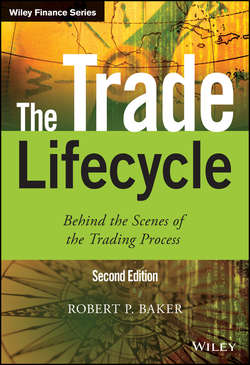Читать книгу The Trade Lifecycle - Baker Robert P. - Страница 18
На сайте Литреса книга снята с продажи.
Part One
Products and the Background to Trading
Chapter 1
Trading
1.8 What do we mean by a trade?
ОглавлениеA trade can be a single transaction or a collection of transactions that are associated together for some reason. In this book, we use the former definition.
A trade is an agreement between two counterparts to exchange something for something else. This book will concentrate on financial trades, which means those involving financial instruments.
Examples of financial trades are:
■ 1000 barrels of West Texas intermediate crude oil for USD 6015
■ 1000 Royal Bank of Scotland ordinary shares for GBP 33.50
■ LIBOR floating rate for five years for 35 basis points per quarter
■ GBP 1 million for JPY 151 million in six months' time
There are many reasons why a trader might transact such trades. To take advantage of expected price rises one would buy (or sell for expected falls). If a large change in price was expected (volatility) but the direction was unknown there are trading strategies (involving call and put options – see Chapter 5) to profit from such a situation. Some trading is motivated by the expected shape of future prices known as the term structure or curve of an asset such as WTI crude oil.
In addition trades are often transacted as hedges to limit exposure to changes in market conditions caused by other trades. We examine hedging in Chapter 10.
The trading parties must agree:
■ what each side is committed to supplying
■ when the agreement takes effect
■ how the transfer is to be arranged
■ under what legal jurisdiction the trade is being conducted.
A trade is in essence a legally binding agreement creating an obligation on both sides. It is important to consider that from the point of agreement, the trade exists. If one side reneges on the trade and nothing is actually transacted, the other side will have legal recourse to compensation.
Trading has benefits and risks. It is an everyday activity we sometimes take for granted, but a transacted trade requires processes to be undertaken from conception to expiry. We will examine the journey of a trade and its components and in doing so will explore the activities of a financial entity engaged in trading.
Trading encompasses many types of trades. Some are standardised with very few differences from a regular template. They are traded in high volumes and require little formal documentation. For example, buying a share in an exchange-listed security would require only the security name, deal date and time, settlement date, quantity and price.
Other trades are far more specialised. They may have hundreds of pages of documentation and take months to put together. They will be traded individually and no two trades will be alike. Even these more complicated trades however are usually made up of components built from simpler, standard trades.
